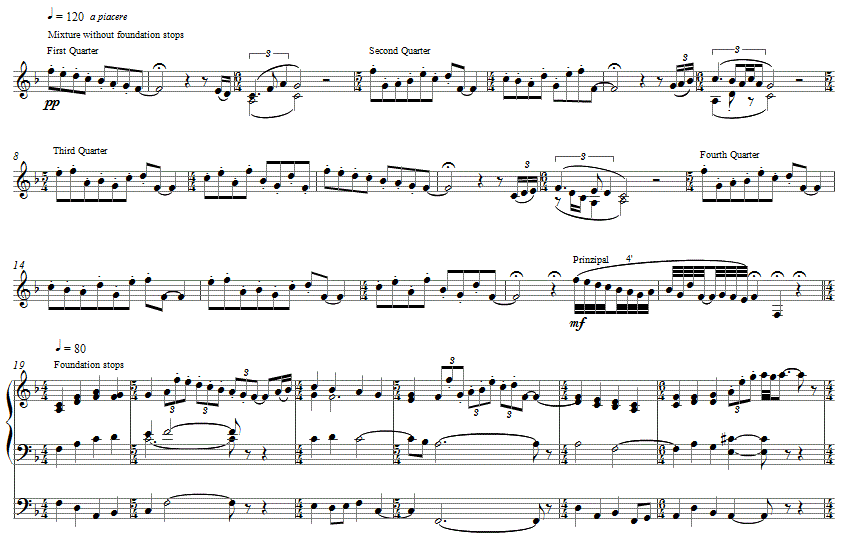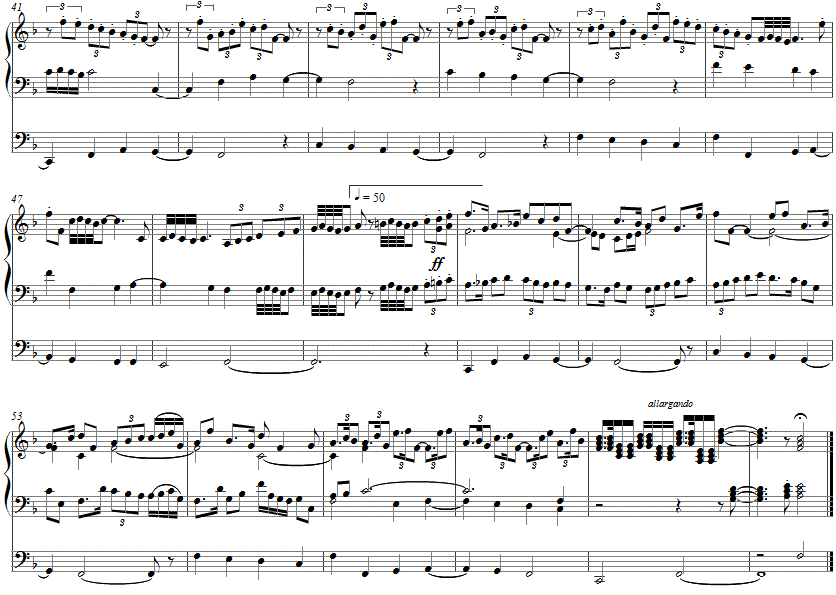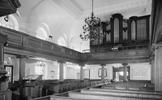Music and Texts of GARY BACHLUND
Vocal Music | Piano | Organ | Chamber Music | Orchestral | Articles and Commentary | Poems and Stories | Miscellany | FAQs
Variations on Saint Michael's and Saint Michael's Chimes - (2010)
for organ
for Barbara and Harvey McCormick on the occasion of their 52nd anniversary
The eighteenth century church in Charleston, Saint Michael's, has a long and fascinating history. In its musical history are the chimes, which once was rung by hand with a chiming clavier [ 1 ].
A cousin, Barbara McCormick, has sung in the choir, and her husband was retelling the story of sitting in the upstairs loft watching the organists play. While relaxing at their home on James Island and with a history of Saint Michael's on their kitchen table, I thought to sketch a set of variations in which the well-reputed Saint Michael's Chime Tune [ 2 ] combined with the named Saint Michael hymn tune by Louis Bourgeois from 1551, found in the French Genevan Psalter.
For this, a mixture stop without underlying fundament would mimic the chimes, each quarter hour separated by a short musical gesture as "curtain," and then the hymn tune in foundation stops following, in which the chime tune is used as a commentary and contrappunto against it. One of the chime tune's "quarter" hours functions as bass line under a statement of the hymn tune.
The several variations conclude with the hymn tune, stated in left hand and pedal and offset by one measure, as echoes of the chime tune sing out above them.
3 pages, circa 3' 20" - an MP3 demo is here:
The score is available as a free PDF download, though any major commercial performance or recording of the work is prohibited without prior arrangement with the composer. Click on the graphic below for this organ score.
Variations on Saint Michael's and Saint Michael's Chimes
NOTES
[ 1 ] The bells of Saint Michael's have an interesting history. The eight bells, cast in London, were installed in the St. Michael Church steeple in Charleston,
South Carolina, in 1764. During the Revolutionary War, the British took the bells back to England.
After the war, a Charleston merchant bought them and sent them back to America. In 1823, when cracks were discovered in them, they were sent back to London to be recast. In 1862, during the Charleston siege, they were moved to Columbia, S.C. for safe keeping, but Sherman’s army set fire to the area, and nothing but fragments of the bells remained. These were sent back to London once more, where the original molds still stood, and again, recast. In February 1867, the eight bells were reinstated in the St. Michael steeple.
The eight bells were played by a chiming clavier, as shown in this century-old photograph. A chiming device such as this strikes the clappers against the stationary bells. The ropes shown were tied to the clappers unlike the ringers’ ropes which are attached to the wheels. The eight bells may e chimed by a single person, but to be rung, the bells require one ringer per bell.
This clavier, though extant, is no longer in use. Chiming is now performed from a keyboard in the choir loft, and by programmed mechanism, I believe. The photo records Washington McLean Gadsden, who chimed the bells for 61 years, retiring on October 1, 1898, dying on July 20, 1899.
The organ case had an inscription as follows, after one of the original pipes -- Jno Snetzler fecit, Londoni, 1767. The instrument today is by Kenneth Jones and Associates, Bray, Ireland, 1994, having restored the original case style and proportions. It has three manuals and pedals, 40 stops, 51 ranks, 2,519 pipes, 6 couplers, tracker key action, mechanical stop action with a parallel electric stop action.
[ 2 ] The chimes have patterns using the full octave in variants which distinguish one from another. Much like the variants of a tone row, these nine gestures ending on the lower tonic employ the tones in unusual melodic ways, given the era in which they were created. A short MP3 of the last or "fourth quarter" chime is here.
1st Quarter: 8,7,6,5,4,3,2,1; 2nd Quarter: 8,2,3,4,7,5,6,1 5,4,3,6,2,7,8,1; 3rd Quarter: 7,8,3,4,2,5,6,1 5,7,3,8,4,2,6,1 8,7,6,5,4,3,2,1; and 4th Quarter: 8,2,3,4,7,5,6,1 5,4,3,6,2,7,8,1 7,8,3,4,2,5,6,1 5,7,3,8,4,2,6,1, with the notes as follows: 1=low F , 2=G, 3=A, 4=Bb, 5=C, 6=D, 7=E, 8=high F.



